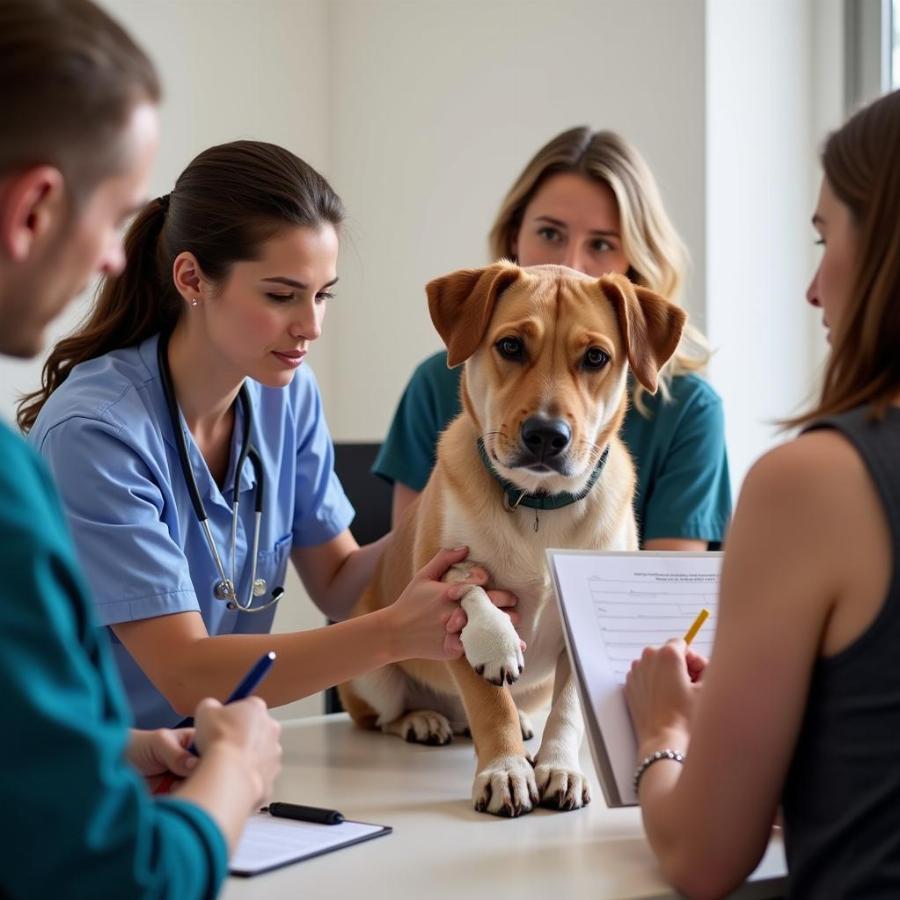A well-stocked dog first aid kit is a must-have for any responsible pet owner. Just like us, our furry friends can experience unexpected injuries or illnesses. Having the right supplies on hand can help you address minor issues quickly and effectively, or stabilize your dog in a more serious situation until you can reach veterinary care. This article will guide you through creating a comprehensive dog first aid kit, equipping you to handle a variety of situations and provide immediate care for your beloved canine companion.
What to Include in a Dog First Aid Kit
Building a dog first aid kit doesn’t have to be complicated. You can start with a basic kit and gradually add items as needed. Consider purchasing a pre-made kit and supplementing it with specific items relevant to your dog’s breed, age, or lifestyle. Remember, a well-organized kit is essential for quick access in an emergency. A waterproof container or bag is ideal for keeping your supplies dry and protected.
Essential Medications and Treatments
- Antiseptic Solution (like Betadine): For cleaning wounds. Always dilute as directed on the product label. You can find more information on using betadine for dogs on our website.
- Antibiotic Ointment: Applies to minor cuts and scrapes after cleaning.
- Sterile Gauze Pads and Non-Stick Bandages: For covering wounds and controlling bleeding.
- Adhesive Tape: To secure bandages.
- Hydrogen Peroxide (3% solution): To induce vomiting if directed by a veterinarian (never induce vomiting without professional guidance).
- Styptic Powder or Pencil: To stop bleeding from minor cuts, especially on nails.
- Tweezers: For removing splinters or ticks.
- Scissors: For cutting gauze or bandages.
- Digital Thermometer: For taking your dog’s temperature rectally.
- Eye Wash Solution: For flushing debris from the eyes.
Other Important Items
- Latex Gloves: To protect yourself from infection.
- Syringe or Bulb Syringe: For administering oral medications or flushing wounds.
- Muzzle: Even the gentlest dog may bite when in pain. A muzzle can protect you and allow you to provide necessary care.
- Leash and Collar/Harness: For safe transport if your dog is injured.
- Towel: For cleaning, comforting, or transporting your dog.
- Small Flashlight: For better visibility in low-light situations.
- Emergency Contact Information: Include your veterinarian’s number, as well as the contact information for the nearest emergency animal hospital. You might also want to research the best place to take dogs in your area beforehand.
What Should I Do if My Dog is Injured?
First, stay calm. Assess the situation and determine the severity of the injury. For minor cuts and scrapes, clean the wound with antiseptic solution and apply antibiotic ointment. For more serious injuries, control any bleeding with pressure and seek immediate veterinary attention.
How Can I Tell if My Dog Needs Emergency Care?
Signs of a veterinary emergency include difficulty breathing, severe bleeding, loss of consciousness, seizures, vomiting or diarrhea that doesn’t stop, inability to walk, or any signs of extreme pain.
Where Can I Find More Information About Dog First Aid?
Many organizations offer dog first aid courses, both online and in person. These courses can provide valuable hands-on training and equip you with the skills to handle various emergency situations.
 Dog First Aid Training
Dog First Aid Training
Is it Safe to Give My Dog Human Medications?
Never give your dog human medications without consulting your veterinarian. Many human medications are toxic to dogs and can cause serious health problems.
How Often Should I Check and Replenish My Dog First Aid Kit?
It’s a good idea to check your dog first aid kit every few months to ensure that medications haven’t expired and that all supplies are adequately stocked. Replenish any used or expired items promptly. This is especially important if you are planning activities like kayaking with a dog where accidents are more likely.
Conclusion
Preparing a dog first aid kit is a crucial step in responsible pet ownership. Having the right supplies readily available can make a significant difference in an emergency, providing immediate care for your furry friend and potentially saving their life. Don’t wait until an accident happens – assemble your dog first aid kit today.
FAQ
- What is the most important item in a dog first aid kit? Contact information for your veterinarian and the nearest emergency animal hospital.
- Can I use hydrogen peroxide on my dog’s wounds? While it can be used to induce vomiting under veterinary guidance, it’s generally not recommended for cleaning wounds, as it can damage healthy tissue.
- Do I need a muzzle in my dog first aid kit? Yes, even a friendly dog can bite when injured. A muzzle protects you while allowing you to administer care.
- How often should I replace the items in my dog first aid kit? Check your kit regularly and replace expired medications and used supplies promptly.
- Where can I learn more about dog first aid? Consider taking a dog first aid course offered by various organizations, both online and in person.
- What if my dog eats something toxic? Contact your veterinarian or animal poison control immediately. Having hydrogen peroxide on hand can be useful if your vet instructs you to induce vomiting, but never do so without professional guidance.
- Can I give my dog human pain medication? Never give your dog human medication without consulting your veterinarian.
Find More Helpful Information on Beaut Dogs
Are you looking for the best hod dog in orlando? Or perhaps you want to know more about dog first aid kits? Explore our website for more helpful articles and resources for dog owners.
Beaut Dogs is your trusted source for all things related to dog care. We offer comprehensive guides on breed selection, health, nutrition, training, and more. For personalized advice or assistance, please email us at [email protected]. We at Beaut Dogs are dedicated to providing dog lovers with valuable information and resources to help them care for their canine companions.